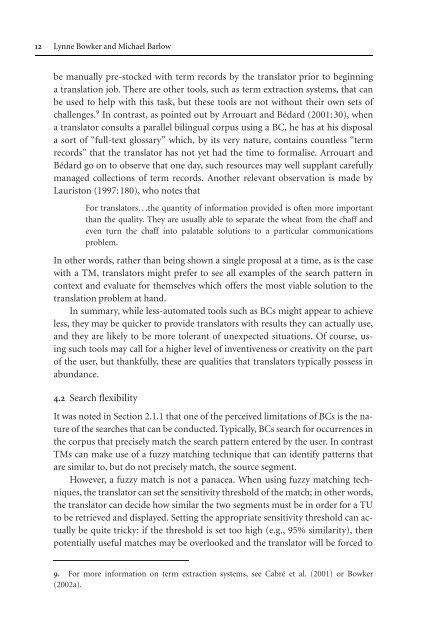Topics in Language Resources for Translation ... - ymerleksi - home
Topics in Language Resources for Translation ... - ymerleksi - home
Topics in Language Resources for Translation ... - ymerleksi - home
- No tags were found...
You also want an ePaper? Increase the reach of your titles
YUMPU automatically turns print PDFs into web optimized ePapers that Google loves.
12 Lynne Bowker and Michael Barlowbe manually pre-stocked with term records by the translator prior to beg<strong>in</strong>n<strong>in</strong>ga translation job. There are other tools, such as term extraction systems, that canbe used to help with this task, but these tools are not without their own sets ofchallenges. 9 In contrast, as po<strong>in</strong>ted out by Arrouart and Bédard (2001:30), whena translator consults a parallel bil<strong>in</strong>gual corpus us<strong>in</strong>g a BC, he has at his disposala sort of “full-text glossary” which, by its very nature, conta<strong>in</strong>s countless “termrecords” that the translator has not yet had the time to <strong>for</strong>malise. Arrouart andBédard go on to observe that one day, such resources may well supplant carefullymanaged collections of term records. Another relevant observation is made byLauriston (1997:180), who notes thatFor translators. . .the quantity of <strong>in</strong><strong>for</strong>mation provided is often more importantthan the quality. They are usually able to separate the wheat from the chaff andeven turn the chaff <strong>in</strong>to palatable solutions to a particular communicationsproblem.In other words, rather than be<strong>in</strong>g shown a s<strong>in</strong>gle proposal at a time, as is the casewith a TM, translators might prefer to see all examples of the search pattern <strong>in</strong>context and evaluate <strong>for</strong> themselves which offers the most viable solution to thetranslation problem at hand.In summary, while less-automated tools such as BCs might appear to achieveless, they may be quicker to provide translators with results they can actually use,and they are likely to be more tolerant of unexpected situations. Of course, us<strong>in</strong>gsuch tools may call <strong>for</strong> a higher level of <strong>in</strong>ventiveness or creativity on the partof the user, but thankfully, these are qualities that translators typically possess <strong>in</strong>abundance.4.2 Search flexibilityIt was noted <strong>in</strong> Section 2.1.1 that one of the perceived limitations of BCs is the natureof the searches that can be conducted. Typically, BCs search <strong>for</strong> occurrences <strong>in</strong>the corpus that precisely match the search pattern entered by the user. In contrastTMs can make use of a fuzzy match<strong>in</strong>g technique that can identify patterns thatare similar to, but do not precisely match, the source segment.However, a fuzzy match is not a panacea. When us<strong>in</strong>g fuzzy match<strong>in</strong>g techniques,the translator can set the sensitivity threshold of the match; <strong>in</strong> other words,the translator can decide how similar the two segments must be <strong>in</strong> order <strong>for</strong> a TUto be retrieved and displayed. Sett<strong>in</strong>g the appropriate sensitivity threshold can actuallybe quite tricky: if the threshold is set too high (e.g., 95% similarity), thenpotentially useful matches may be overlooked and the translator will be <strong>for</strong>ced to9. For more <strong>in</strong><strong>for</strong>mation on term extraction systems, see Cabré et al. (2001) or Bowker(2002a).
















